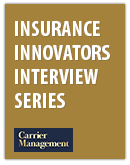Failing to innovate is no longer an option in the property/casualty insurance industry, according to leaders who say that a tolerance for ill-timed or less-than-perfect product launches is better than the alternative—not making any risky innovative moves at all.
Executive Summary
P/C insurance leaders reveal their innovation failures and greatest successes.“Innovation is not a qualifier for success. A company has to be prepared to fail in order to learn from mistakes,” said Kevin Kelley, chief executive officer of Ironshore.
“A corporate culture of innovation requires both resilience and persistence,” he said. “The commitment to innovate cannot lose momentum when an idea becomes derailed. Absence of innovation, however, will most likely result in failure over the longer term.”
David Lightfoot, managing director and head of GC Analytics-Americas at reinsurance broker Guy Carpenter, agrees. “Tolerance for failure is clearly important to innovation. What you learn from a failed experiment is often more important than what you derive from one that works,” he wrote in an email responding to a question about lessons learned from innovation failures.

“The commitment to innovate cannot lose momentum when an idea becomes derailed. Absence of innovation, however, will most likely result in failure over the longer term.”
Kevin Kelley, Ironshore
“Several years ago we built a model to evaluate the ‘riskiness’ of portfolios subject to casualty-based catastrophe losses. We categorized portfolios as high, medium or low riskiness relative to other portfolios. However, this information didn’t resonate with our client base, as it was hard for our clients to develop risk management strategies on the riskiness level. They needed a quantification of the risk.
“As a result, in our GC ForCas model, we made sure that the model provides a credible estimation of potential loss from casualty catastrophes,” he said, referring to a recent innovation success launched in March.
At Assurant, CEO Alan Colberg recalled his company’s failed launch of an insurance bundle for the solar industry several years ago. The bundle incorporated property and liability insurance with warranty management, he said. “While the solar industry recognized the need for the product and warmly welcomed us into the marketplace, we quickly realized we had entered the market too early to generate the returns we required. It is critical to consider the timing for new market entries carefully, have a solid understanding of a market’s maturity and the best time to invest.”
Mark Watson, CEO of Argo Group, said his company learned a different lesson from an insurance product designed for small-business bank accounts, offering protection against thefts from phishing, malware and other cyber attacks. “In all aspects, it showed significant promise. But to have success in launching a product, even a winner takes a combination of innovations, in areas such as distribution techniques, marketing options, pricing, etc.
“We relied too heavily on some traditional methods in those areas when we introduced the product,” Watson reported. “In the end, the key takeaway for us was that innovation has to be part of the entire offering—not just the product.”
At XL Catlin, Greg Hendrick, CEO of Reinsurance, couldn’t pinpoint a totally failed initiative. “If we learned from it, we didn’t fail,” he said, adding, however, that “an innovative new product is not always an easy sell.”
“It takes time for our brokers and clients to grow comfortable with a new approach or product,” he said, noting that what he views as one of the company’s greatest recent innovation successes—a construction contractors product known as CapAssure—”was not an overnight sensation.”
“What we’ve learned from that experience is to trust our instinct that we’ve built a high-value, useful product,” he said.
The Winners
In 2011, XL launched an internal innovation competition called Competition 25 to commemorate the company’s 25th anniversary, Hendrick said, recalling that CapAssure was the top winner. CapAssure protects large, private construction owners from the risk of default by general contractors and protects general contractors from the risk of default by subcontractors. “By bringing together our surety and subcontractor default underwriting capabilities, we developed a very flexible insurance product to address performance risk securitization,” he said. (Editor’s Note: A March 2012 media statement about CapAssure explains that the product provides an alternative to letters of credit and other capital requirements. It also eliminates coverage redundancies and gives project owners more control in a default scenario to directly manage project completion.)

Success of a new product relies heavily on education and communication. And that takes time.
Greg Hendrick, XL Catlin
Also in the construction arena is a more recent innovation called P3 Plus. “This is a creative approach to managing the design, construction, operational and maintenance phases of the risks associated with public private partnerships (aka P3s), an innovative team approach for public entities and private companies to work together to accomplish much-needed construction of roads, bridges and other essential infrastructure,” Hendrick said.
Recounting another recent XL success story addressing a company-specific situation in the energy sector, Hendrick said the insurer innovation—a performance warranty insurance product designed for Bloom Energy of Sunnyvale, Calif.—came from XL’s Complex Accounts team based in Zurich. Complex Accounts was set up in 2012 with the directive “to design custom-built risk solutions for innovative companies, which are often pushing the boundaries themselves and have found that standard insurance coverage has not met their needs,” he said.
The insurance solution “enabled Bloom Energy to finance the installation of dozens of Bloom Energy Servers. These systems are expected to generate over 50 million kilowatt hours of clean, reliable electricity, and the insurance policy assures the performance of Bloom’s fuel-cell server technology over the term of the financing,” Hendrick said.
A key industry player influential in crafting the Bloom Energy solution was consultant Tom Hutton, CEO and founder of New Energy Risk Inc., a former XL director. Hutton is now leading a new innovation initiative at XL—related to investing rather than insurance underwriting—known as XL Innovate, according to XL Catlin Group CEO Mike McGavick. The XL Innovate initiative, McGavick explained, is an XL-sponsored venture capital fund through which XL will seek to “partner with entrepreneurs who have the vision and ambition to address new risks with new solutions, unconstrained by geography, scale or traditional thinking.”
XL Catlin is not the only P/C insurer to set up a venture capital arm investing in innovators outside of the insurance industry. In June 2014, American Family Insurance and Microsoft announced the launch of a business accelerator for startups focused on home automation. And in late February 2015, AXA announced the launch of a €200 million venture capital fund backing startups bringing innovations to the insurance, asset management, financial technology and healthcare service industries.
Innovating With Tech Tools
At ACE Group, Vice Chair John Lupica believes his company’s most successful innovation isn’t a risk transfer product but an online insurance program management platform first launched five years ago, known as ACE Worldview. The platform, available to large commercial insureds with complex P/C insurance programs, allows them to track the issuance of a local multinational policy, electronically sign coverage selection forms, view billing online and access claims predictive analytics, Lupica said.
Noting that the platform was created in reaction to client and broker requests to “make their lives easier,” Lupica said a more recent innovation does that and more. “In 2014, our clients challenged us to keep our company flat and nimble, and we responded with our Worldview Communities. These communities are a virtual underwriting and servicing portal and will bring together all the experts at ACE, with the broker and client, to collaborate and provide superior service,” he said.
At Navigators, CEO Stanley Galanski also looked beyond risk transfer products, pointing to internal information exchange tools connecting in-house professionals from different disciplines as the greatest innovation at his company over the last decade. “Combining industry-leading access to data with mobility has been a winning combination,” he said.
The marriage of “proprietary and home-grown management information capabilities with mobile technology” means that underwriters and claims professionals “can access amazingly detailed management information on the performance of their books of business from an iPad,” he explained.
Technology for analyzing risks is at the top of the lists of success stories shared by Guy Carpenter’s Lightfoot and Ming Lee, CEO of AIR Worldwide.
“One of our greatest innovations was and continues to be MetaRisk,” said Lightfoot, reflecting on his 15 years at the reinsurance broker. “It was the first broadly used dynamic financial analysis tool in the industry and brought actuarial science methodology to reinsurance pricing optimization and then to capital management. Since its initial release over 20 years ago, it has created a fundamental shift in companies’ understanding of risk and enabled them to use that understanding to drive better business decisions,” he said.

“What you learn from a failed experiment is often more important than what you derive from one that works.”
David Lightfoot, Guy Carpenter
“A more recent example of an innovative initiative strongly resonating with our clients is our Model Suitability Analysis initiative,” he said, explaining that MSA is “a rigorous and transparent catastrophe model evaluation framework, providing…clients with increased confidence in the catastrophe model results.”
While Guy Carpenter is offering carriers an ability to assess cat models, Lee says “without a moment’s hesitation” that AIR Worldwide’s greatest innovation is not a single [cat] model but an open risk management environment known as Touchstone that allows users to incorporate models from other firms.
Other notable features of Touchstone, which Lee refers to as “upstream components,” give users “the ability to assess and improve the quality of exposure data, perform account underwriting and exposure management, and assess both cat and noncat loss potential. Downstream components include portfolio management at the business-unit level and the ability to roll up everything to the enterprise level.”
In addition, built-in geospatial tools help users “to visualize and analyze their risk from a portfolio view down to a single address,” he said.
Reflecting on the history of AIR Worldwide, Lee said, “We invented the catastrophe modeling industry back in 1987 and have built on that achievement ever since.” (See related article, “Can Karen Clark Move Forward the Cat Modeling Industry She Helped Create?“) “We were the first to introduce numerical weather prediction modeling into our windstorm models, and we were the first to couple global climate models with NWP to assess U.S. flood risk at high resolution.”
Transformation and Collaboration
While Hendrick and Lightfoot pointed to catastrophe risk analysis as the most transformative innovation for the P/C industry in recent memory, it was the transformation of his company’s entire business model—from a U.S. workers compensation provider to a global underwriter of specialty insurance and reinsurance—that Argo’s Watson ranked as the greatest innovation for his company individually. With a long-term strategy taking shape over the last decade, supported by “a formidable dose of selectivity” in decisions from underwriting individual risks to regional expansions, Argo grew its capital from a few hundred million to more than $2 billion, Watson said.
Innovation, however, is not always an individual company activity, leaders said, with Watson and Kelley citing the backing of reinsurers as an essential ingredient in delivering new coverages for emerging risks. Building on the same idea, Berto Sciolla, manager of North American Treaty Reinsurance for Gen Re, provided a reinsurer’s perspective.
“We offer a cyber insurance product for primary insurers, combined with reinsurance,” Sciolla said. “Cyber insurance is not all that new by now, although not all insurers or reinsurers offer it. We took a unique approach of teaming up with a leader in the cyber insurance service space, Beazley. Gen Re and Beazley combined their strengths—pricing tools, policy forms development, breach response management and claims handling—into one product offering with reinsurance. For the insurer, all of that expertise is combined and available in one-stop shopping directly from us.
“As the cyber exposures and insurance needs continue to evolve, that teamwork helps ensure we respond with the best product and service solutions.” (Editor’s Note: The cyber insurance is written on the paper of Gen Re’s customer—the primary insurer. Gen Re is the reinsurer and delivers product support, while Beazley provides breach response and claim services.)
 “ACE Worldview has changed the way risk managers and their teams approach their complex, global insurance programs.”
“ACE Worldview has changed the way risk managers and their teams approach their complex, global insurance programs.”
John Lupica, ACE Group
Other industry executives shared specific examples of partnering with direct competitors, including XL’s McGavick, who described taking part in the recently announced Microinsurance Venture Incubator Consortium—a multi-insurer and broker project committed to delivering risk management solutions to the underserved in developing countries in Latin America, Africa and emerging Asia.
“Many insurers realize there are some risks that are best not to tackle alone. Together, however, we can address these risks by pooling our resources. While limiting our individual downside risk, we can bring to the table our greatest skills and assets to address some big problem and really show the value and potential of insurance as a solution,” McGavick said.
External Partners and Disrupters
Still other industry leaders shared examples of product-specific collaborations with partners outside of the insurance industry. Assurant’s Colberg, for example, described a program known as JUMP, packaging a mobile device protection offering with a “premium handset upgrade program,” launched in partnership with T-Mobile.
“Understanding consumer desire for the latest smartphone and the risk event, we were able to create a hugely successful program with T-Mobile that provides handset insurance, extended service protection and mobile security, and all with the ability to upgrade or trade in your device at any time,” he said.
Hendrick pointed to partnerships with outside risk consultants, which allow XL Catlin to provide risk assistance to insureds. “As an example, in North America we’ve partnered with the Acheson Group—founded by Dr. David Acheson, who formerly headed the U.S. Food and Drug Administration—to provide our clients with the best product recall advice,” he said. “We really aim to create a dynamic partnership. We don’t want to be the company that just issues their insurance policy and addresses a loss if something happens.”
Colberg and Hendrick provided these particular examples when asked specifically how insurers might innovate beyond risk transfer—and whether P/C insurers can disrupt other industries. As Google and online retailers make moves that could disrupt the business of P/C insurance, Carrier Management also asked all 16 executives to identify the innovation or innovator that has had the most disruptive impact on the industry so far.
Only three executives (out of a dozen responding) specifically named Google. (A fourth noted that Google is a force to be reckoned with going forward.)
Google aside, technology and technology firms, generally, are having a positive impact, insurance leaders said, with smartphones and all things digital, the “Internet,” and increased computing power all being mentioned as game-changers in assessing risk and connecting with customers.
What has been the most impactful innovation coming from within the P/C insurance industry?
The use of big data and predictive analytics were most frequently mentioned by P/C insurance executives responding to Carrier Management. Another clear contender for the internal “Google” is “telematics,” also garnering four votes from the executives. Honorable mentions went to construction wrap-ups, employment practices liability insurance and catastrophe risk analysis.
Where will the next innovation to impact the P/C insurance industry come from?
Among 14 respondents, no one said unequivocally that it would come from within the industry—and five were certain it would come from outside. More optimistic forecasters predicted that insurers would work with technology players to develop the next big idea to transform the insurance business.
Details of the responses are published exclusively on carriermanagement.com in the following articles:
- Greatest P/C Industry Innovation
- Noninsurance Innovations Seen as Transformational
- The Next Impactful Innovator: Will It Be Google?
- Can P/C Insurers Be Disruptive Innovators?
Related Articles:
- P/C Insurers Getting Innovative About Innovation Processes
- P/C Insurers Blocking Their Own Roads to Innovation
 Get all 16 interview neatly packaged in a single PDF download. Explore ideas by personality and by question. More than 60 pages of content.
Get all 16 interview neatly packaged in a single PDF download. Explore ideas by personality and by question. More than 60 pages of content.





















 Northern California Flooding This Weekend Caused by Heavy Rain, High Tides
Northern California Flooding This Weekend Caused by Heavy Rain, High Tides  Final Sentencing in Large Scale Crop Fraud Case That Cost Insurers Nearly $35M
Final Sentencing in Large Scale Crop Fraud Case That Cost Insurers Nearly $35M  Executives on the Move at Liberty Mutual, Cowbell, W. R. Berkley
Executives on the Move at Liberty Mutual, Cowbell, W. R. Berkley  Carrier Management’s 2025 Top Features (Reader’s Picks Unlocked)
Carrier Management’s 2025 Top Features (Reader’s Picks Unlocked) 








